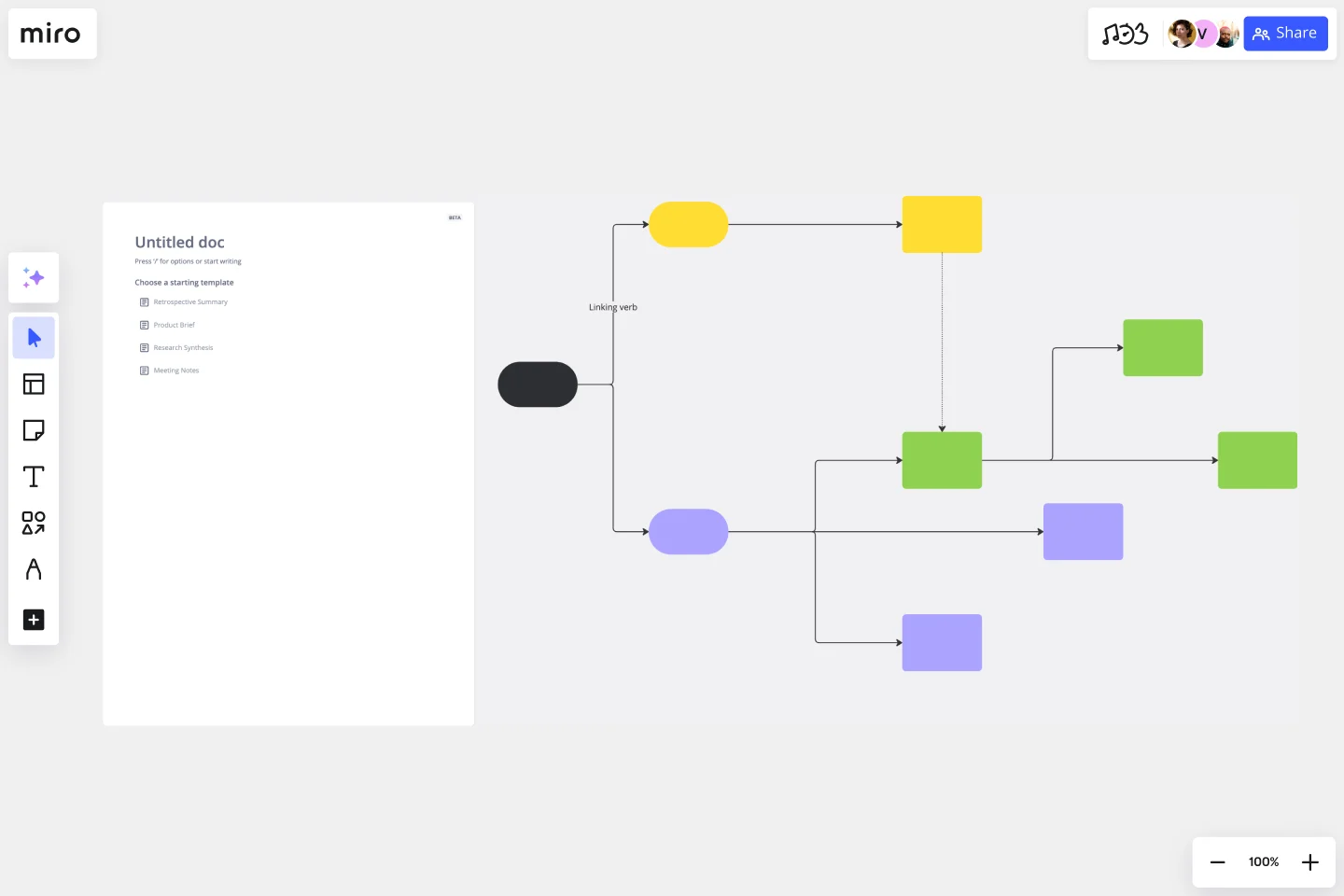About the 5W2H Template
The 5W2H framework is a valuable tool that can help you streamline your thought process and improve your project management skills. This structured approach involves answering seven questions that can help you gather and organize information effectively.
The questions are: Who, What, When, Where, Why, How, and How Much. You can make informed decisions and achieve better outcomes by examining a situation comprehensively.
What: Identify the core task or issue.
Why: Understand the purpose or motive behind it.
Who: Pinpoint the people or teams involved.
When: Establish the timeline and deadlines.
Where: Specify the location or context.
How: Explore the methods or processes.
How Much: Determine the resources or quantities involved.
This template is a guiding framework, ensuring no crucial aspect is overlooked.
How to use the 5W2H Template in Miro
Edit easily: Customize the template effortlessly by filling in relevant details or changing the questions.
Expand with a click: Effortlessly expand the template to explore details with a single click, providing a deeper dive into each element.
Add contextual artifacts: Enhance your board by incorporating documents, images, or other artifacts that provide additional context to your 5W2H analysis.
Why should you use a 5W2H Template?
1. Clarity and focus: The template provides a structured approach, helping teams clarify objectives and focus on key aspects.
2. Efficient problem solving: the 5W2H template facilitates thorough problem analysis and effective solutions by addressing all relevant questions.
3. Improved communication: Enhance communication within teams by ensuring that everyone is on the same page regarding project details.
4. Time management: Clearly defined timelines and deadlines ensure better time management, reducing delays and improving project efficiency.
5. Comprehensive understanding: The template encourages a thorough understanding of a situation, minimizing the risk of overlooking critical details.
5W2H Template FAQs
Is the 5W2H template suitable for all types of projects?
Yes, the template's versatility makes it applicable to various projects, from simple tasks to complex problem-solving scenarios.
How can I get all crucial information when using the template?
The structured nature of the 5W2H template guides you through each essential question, reducing the likelihood of overlooking key details.

Miro
Your virtual workspace for innovation
Miro is an innovation workspace designed for teams of every size, everywhere, to dream, design, and build the future together. Our mission? To empower these teams to create the next big thing, powered by AI at every step of the way. Over 90 million users around the world rely on Miro to untangle complex ideas, put customer needs first, and deliver products and services faster. All supported by best-in-class security, compliance, and scalability.
Categories
Similar templates
5W1H Template

5W1H Template
The 5W1H Template is a strategic framework that clarifies complex situations or projects into six foundational questions: What, Who, Where, When, How, and Why. This methodological approach ensures a comprehensive understanding, encouraging teams to dissect and explore every aspect of a given challenge or project.
Project Planning Mind Map

Project Planning Mind Map
The Project Planning Mind Map Template offers clarity and strategic insight for efficient project management. Its intuitive color-coding functionality makes it easy for your team to navigate complex details easily. You can assign distinct colors to different project elements, promoting efficient decision-making and collaboration. With our mind map template, project planning becomes a seamlessly visual and insightful experience.
Concept Map Template

Concept Map Template
Use the concept map template to create new ideas, structure your thoughts, and bring your innovations to life. It allows you to explore connections between concepts and let your creativity flow in an organized format. As a result, you’re able to visualize how to bring your new ideas to reality and how various concepts relate to each other.
Design Research Template

Design Research Template
A design research map is a grid framework showing the relationship between two key intersections in research methodologies: mindset and approach. Design research maps encourage your team or clients to develop new business strategies using generative design thinking. Originally designed by academic Liz Sanders, the framework is meant to resolve confusion or overlap between research and design methods. Whether your team is in problem-solving or problem space definition mode, using a research design template can help you consider the collective value of many unrelated practices.
5W1H Template

5W1H Template
The 5W1H Template is a strategic framework that clarifies complex situations or projects into six foundational questions: What, Who, Where, When, How, and Why. This methodological approach ensures a comprehensive understanding, encouraging teams to dissect and explore every aspect of a given challenge or project.
Project Planning Mind Map

Project Planning Mind Map
The Project Planning Mind Map Template offers clarity and strategic insight for efficient project management. Its intuitive color-coding functionality makes it easy for your team to navigate complex details easily. You can assign distinct colors to different project elements, promoting efficient decision-making and collaboration. With our mind map template, project planning becomes a seamlessly visual and insightful experience.
Concept Map Template

Concept Map Template
Use the concept map template to create new ideas, structure your thoughts, and bring your innovations to life. It allows you to explore connections between concepts and let your creativity flow in an organized format. As a result, you’re able to visualize how to bring your new ideas to reality and how various concepts relate to each other.
Design Research Template

Design Research Template
A design research map is a grid framework showing the relationship between two key intersections in research methodologies: mindset and approach. Design research maps encourage your team or clients to develop new business strategies using generative design thinking. Originally designed by academic Liz Sanders, the framework is meant to resolve confusion or overlap between research and design methods. Whether your team is in problem-solving or problem space definition mode, using a research design template can help you consider the collective value of many unrelated practices.